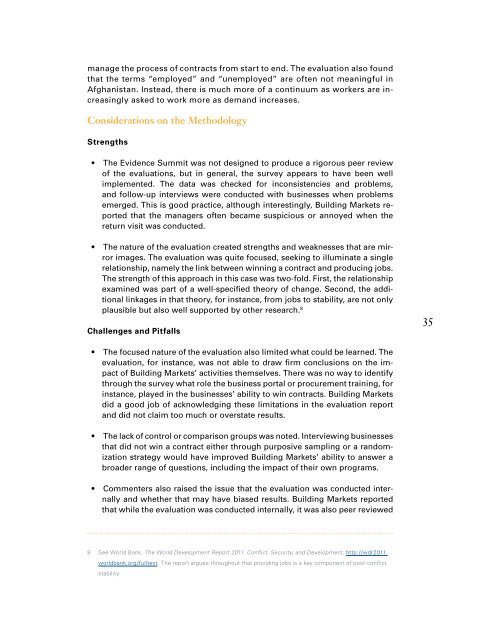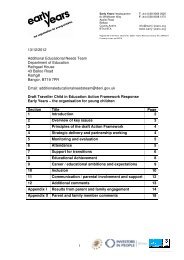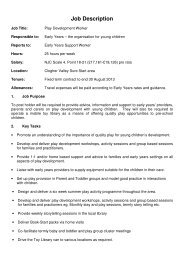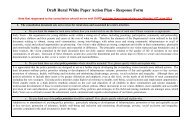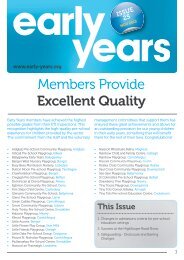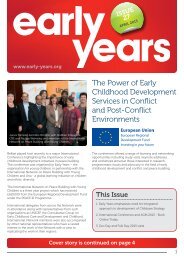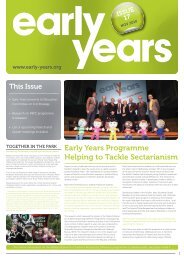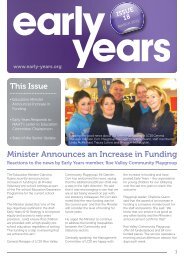Learning from Nine Examples of Peacebuilding Evaluation
Learning from Nine Examples of Peacebuilding Evaluation
Learning from Nine Examples of Peacebuilding Evaluation
You also want an ePaper? Increase the reach of your titles
YUMPU automatically turns print PDFs into web optimized ePapers that Google loves.
manage the process <strong>of</strong> contracts <strong>from</strong> start to end. The evaluation also found<br />
that the terms “employed” and “unemployed” are <strong>of</strong>ten not meaningful in<br />
Afghanistan. Instead, there is much more <strong>of</strong> a continuum as workers are increasingly<br />
asked to work more as demand increases.<br />
Considerations on the Methodology<br />
Strengths<br />
• The Evidence Summit was not designed to produce a rigorous peer review<br />
<strong>of</strong> the evaluations, but in general, the survey appears to have been well<br />
implemented. The data was checked for inconsistencies and problems,<br />
and follow-up interviews were conducted with businesses when problems<br />
emerged. This is good practice, although interestingly, Building Markets reported<br />
that the managers <strong>of</strong>ten became suspicious or annoyed when the<br />
return visit was conducted.<br />
• The nature <strong>of</strong> the evaluation created strengths and weaknesses that are mirror<br />
images. The evaluation was quite focused, seeking to illuminate a single<br />
relationship, namely the link between winning a contract and producing jobs.<br />
The strength <strong>of</strong> this approach in this case was two-fold. First, the relationship<br />
examined was part <strong>of</strong> a well-specified theory <strong>of</strong> change. Second, the additional<br />
linkages in that theory, for instance, <strong>from</strong> jobs to stability, are not only<br />
plausible but also well supported by other research. 8<br />
Challenges and Pitfalls<br />
35<br />
• The focused nature <strong>of</strong> the evaluation also limited what could be learned. The<br />
evaluation, for instance, was not able to draw firm conclusions on the impact<br />
<strong>of</strong> Building Markets’ activities themselves. There was no way to identify<br />
through the survey what role the business portal or procurement training, for<br />
instance, played in the businesses’ ability to win contracts. Building Markets<br />
did a good job <strong>of</strong> acknowledging these limitations in the evaluation report<br />
and did not claim too much or overstate results.<br />
• The lack <strong>of</strong> control or comparison groups was noted. Interviewing businesses<br />
that did not win a contract either through purposive sampling or a randomization<br />
strategy would have improved Building Markets’ ability to answer a<br />
broader range <strong>of</strong> questions, including the impact <strong>of</strong> their own programs.<br />
• Commenters also raised the issue that the evaluation was conducted internally<br />
and whether that may have biased results. Building Markets reported<br />
that while the evaluation was conducted internally, it was also peer reviewed<br />
8 See World Bank, The World Development Report 2011: Conflict, Security, and Development, http://wdr2011.<br />
worldbank.org/fulltext. The report argues throughout that providing jobs is a key component <strong>of</strong> post-conflict<br />
stability.


